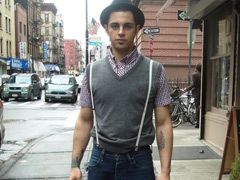


Some have been intrinsically linked to local neighbourhoods, while others are directly imported from other countries (we may have the US to thank for hipster fashion for instance). Trends come and go like the subcultures they pertain to, and while London hasn’t seen a movement as riotous as punk since, well, punk, we have seen a whole host of more subdued groups like goths, emos and nu ravers. While they may have done little for culture they did make a mark on the catwalk – remember Gucci’s gothic bondage-inspired collection? Here are the styles you most certainly will have spotted around town.
Sloanies
The term Sloane Ranger first appeared in the 80s, at the height of shoulder pad fashion and frizzy short haircuts a la Lady Di; in fact, much of the archetypal Sloane Ranger seems to be directly inspired by her (the male equivalent was called a Hooray Henry). The term was first coined in the 1982 book ‘Sloane Ranger Handbook’, inspired by their main stomping ground around Sloane Street. These were the days before it was a must to pretend you were from the ghetto despite having grown up in Herefordshire, a more innocent time when Princess Diana was a role model and reality television was but a twinkle in a very young producer’s eye. In the 90s these prim and proper ladies became IT girls, more trashy than preppy and with a propensity to drink in equal measures to their counterparts the ladettes, but in swanky bars rather than The Pitcher and Piano. The media may have neatly categorised them for the noughties into Turbo Sloanes, Eco Sloanes, etc, but the Channel 4 show Made in Chelsea is supposedly giving us plebs a glimpse into the lives of real Sloanies today, and they’re simply rich kids who want to be like Jordan. One of them is called Gabbalicious, for goodness sake.
Uniform: Much has changed from the country-inspired macintosh and ballet pumps combo Sloanies used to wear in the 80s. Today’s posh girls wear boho-inspired, floaty numbers by day and glitzy, revealing outfits with sky-high platforms by night, not forgetting spray tans and lip gloss. \n\nCroydon facelift
Sometimes used interchangeably with ‘pram face’, the ‘Croydon facelift’ is used to describe a style of pony-tail where the hair is pulled back extremely tightly and tied at the top of the head with a hair band or scrunchie. Hair gel may be employed to keep hairs in place, and the skin on the forehead can sometimes appear stretched. Although this hair style has become synonymous with working class females, (and used in a derogatory fashion), let’s pause for a moment to reflect on this. Anyone who reads magazines, newspapers or watches television will know that Sarah Jessica Parker is a huge fan, having worn her hair atop her head in this manner to numerous fashion shows. And only last month newly single Jennifer Lopez showed off her cheekbones by scraping her hair back and knotting it into a bun on the top of her scalp.
Uniform: If we’re talking SJP at the Leicester Square premiere of her latest film, then Louboutin heels and a sharply tailored Alexander McQueen dress. Back in the real world, it’s more likely to accompany the sort of clothes you wear when you nip out to buy a loaf of bread.
Hipsters
Formerly known as Hoxtonites, everyone loves to hate a hipster. Their fashion sense is meant to be non-conformist and break all the rules, which is why they all shop at the same select vintage stores in E1 as well as having the odd splurge at American Apparel. In fact, there is a great book waiting to be written about how the root of hipsterdom and consequently of all evils is because of American Apparel. Or maybe a blog. Within hipster culture you will also find hipstirrers, know-it-alls who like to spread gossip between the Cat and Mutton and the George and Dragon.
Uniform: But uniforms are like, so totalitarian, you know? However hipster style is possibly the easiest style to spot, because there is little variation. And now that hipsters have spread as far afield as Cyprus, all of a sudden the market for prescription NHS specs has quadrupled, but we hear they haven’t quite got the hang of Converse yet, as they’ve got to be slightly torn and covered in stains for that authentic spent-all-night-at-an-indie-gig look.
\n\nRude boys
This was the term given to young men in Jamaica in the 60s who were supposedly just that, rude. They indulged in naughty behaviour of the criminal kind, and as ska was a prevalent form of music at the time the two became interlinked when they were imported to the UK in 1970s at the height of the skinhead era. Fast-forward to London today and the term is used to describe anyone who thinks they’re hard, particularly in cases when they are almost definitely not.
Uniform: Today a rude boy is less of a definition of a subculture as a way of mocking someone who thinks they’re some sort of gangster, but it’s more likely to be directed at white middle class boys sporting baseball caps, baggy jeans and hooded tops. They smarten their act up with check shirts with the top button done up and waving their arms in the air constantly as if there’s a fire.


